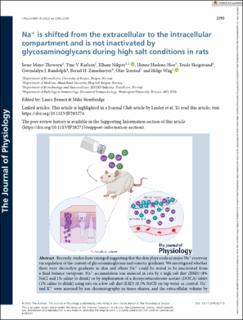Na+ is shifted from the extracellular to the intracellular compartment and is not inactivated by glycosaminoglycans during high salt conditions in rats
Thowsen, Irene Matre; Karlsen, Tine Veronica; Nikpey, Elham; Haslene-Hox, Hanne; Skogstrand, Trude; Randolph, Gwendalyn J.; Zinselmeyer, Bernd H.; Tenstad, Olav; Wiig, Helge
Journal article, Peer reviewed
Published version

Åpne
Permanent lenke
https://hdl.handle.net/11250/3044958Utgivelsesdato
2022Metadata
Vis full innførselSamlinger
- Department of Biomedicine [710]
- Registrations from Cristin [9791]
Sammendrag
Recently, studies have emerged suggesting that the skin plays a role as major Na+ reservoir via regulation of the content of glycosaminoglycans and osmotic gradients. We investigated whether there were electrolyte gradients in skin and where Na+ could be stored to be inactivated from a fluid balance viewpoint. Na+ accumulation was induced in rats by a high salt diet (HSD) (8% NaCl and 1% saline to drink) or by implantation of a deoxycorticosterone acetate (DOCA) tablet (1% saline to drink) using rats on a low salt diet (LSD) (0.1% NaCl) on tap water as control. Na+ and K+ were assessed by ion chromatography in tissue eluates, and the extracellular volume by equilibration of 51Cr-EDTA. By tangential sectioning of the skin, we found a low Na+ content and extracellular volume in epidermis, both parameters rising by ∼30% and 100%, respectively, in LSD and even more in HSD and DOCA when entering dermis. We found evidence for an extracellular Na+ gradient from epidermis to dermis shown by an estimated concentration in epidermis ∼2 and 4–5 times that of dermis in HSD and DOCA-salt. There was intracellular storage of Na+ in skin, muscle, and myocardium without a concomitant increase in hydration. Our data suggest that there is a hydration-dependent high interstitial fluid Na+ concentration that will contribute to the skin barrier and thus be a mechanism for limiting water loss. Salt stress results in intracellular storage of Na+ in exchange with K+ in skeletal muscle and myocardium that may have electromechanical consequences.
